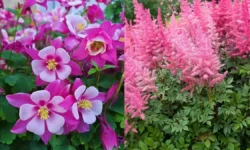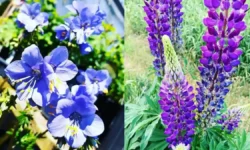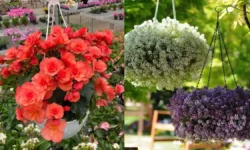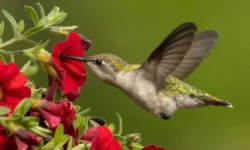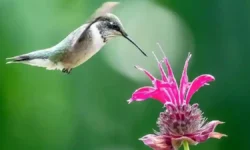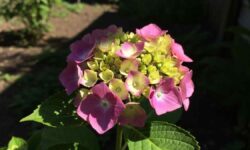The Split Leaf Philodendron and Monstera are two of the most popular tropical houseplants, often admired for their lush, deeply lobed or perforated leaves. Many people confuse these two plants because of their similar leaf shapes, but they belong to different genera and have distinct characteristics. Understanding their differences is crucial for proper care and to ensure you choose the right plant for your indoor or outdoor space.
The Split Leaf Philodendron, also known as Philodendron bipinnatifidum or Thaumatophyllum bipinnatifidum, is a member of the Araceae family and originates from South America. Its large, deeply lobed leaves give it a dramatic, tropical appearance. In contrast, Monstera deliciosa, commonly referred to as the Swiss Cheese Plant, is also part of the Araceae family but comes from Central American rainforests. Its iconic fenestrated leaves with natural holes make it instantly recognizable.
In this detailed comparison, we will explore their differences in appearance, care requirements, growth habits, and ideal growing conditions. We will also provide a side-by-side comparison table to help you quickly identify which plant suits your needs best.
Table of Contents
Origin and Natural Habitat
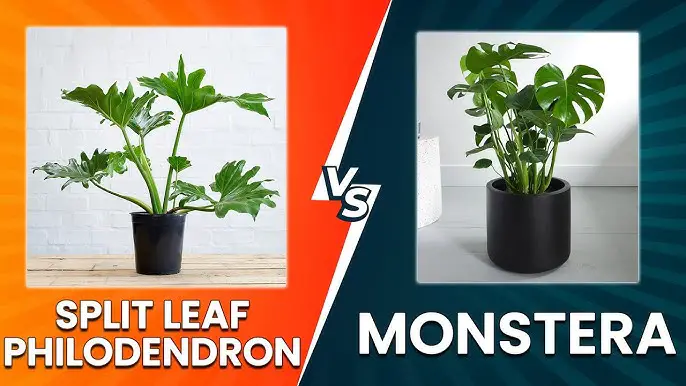
Split Leaf Philodendron Origin
The Split Leaf Philodendron is native to Brazil, Paraguay, and northern Argentina, where it thrives in tropical and subtropical climates. It typically grows under the canopy of large trees, benefiting from filtered sunlight and high humidity. In the wild, it can reach impressive sizes, forming a thick trunk and wide-spreading leaves that create a lush ground cover. Its adaptation to shaded environments makes it an excellent choice for indoor plant lovers.
Monstera Origin
Monstera deliciosa originates from the rainforests of Mexico, Panama, and other parts of Central America. It naturally climbs up trees using its aerial roots to reach higher levels of light in dense jungles. This climbing habit is one of the plant’s most distinguishing features, allowing it to grow vertically indoors when supported by a moss pole or trellis. Its ability to tolerate various light conditions has made it one of the most sought-after houseplants worldwide.
Appearance and Leaf Structure
Split Leaf Philodendron Leaves
The Split Leaf Philodendron features large, deeply lobed leaves that can grow up to three feet wide in mature plants. Unlike Monstera, these leaves do not have natural holes or fenestrations. Instead, they are deeply cut into finger-like sections, giving them a lush, bushy look. The leaves are leathery, glossy, and supported by long, thick petioles, which emerge from a stout trunk as the plant matures.
Monstera Leaves
Monstera leaves are iconic for their unique perforations and holes, which develop as the plant matures. These natural splits help the plant withstand heavy rain and strong winds in its natural habitat. The leaves can grow even larger than those of the Split Leaf Philodendron, often exceeding three feet in width under ideal conditions. The glossy, heart-shaped leaves with distinctive fenestrations give the plant its famous “Swiss cheese” appearance.
Growth Habits and Size
Split Leaf Philodendron Growth Habit
The Split Leaf Philodendron grows more like a shrub than a climbing vine. As it matures, it develops a thick, woody stem and can reach up to 10 feet tall and wide indoors, while outdoor specimens in tropical climates can grow much larger. Its leaves emerge from a central trunk, creating a full, rounded shape that makes it ideal as a floor plant or outdoor landscape feature.
Monstera Growth Habit
Monstera, on the other hand, is a natural climber. Its aerial roots attach to tree trunks or moss poles, allowing it to grow vertically. Indoors, it can reach heights of 8 to 15 feet when given proper support. Its vining nature makes it a versatile plant that can be trained to grow along walls, trellises, or left to cascade from hanging baskets. This difference in growth habit is one of the key distinctions between the two plants.
Care Requirements
Light and Temperature
Both plants thrive in bright, indirect light but can tolerate lower light conditions. However, Monstera tends to adapt better to medium or low light, although it may produce fewer fenestrations in such environments. The Split Leaf Philodendron prefers slightly brighter conditions to maintain its full leaf size and vibrant green color.
In terms of temperature, both plants thrive in warm, humid conditions between 65°F and 85°F. The Split Leaf Philodendron is slightly more tolerant of cooler temperatures, while Monstera prefers consistent warmth and does not handle cold drafts well.
Watering and Humidity
The Split Leaf Philodendron requires regular watering, allowing the top inch of soil to dry between waterings. It enjoys moderate to high humidity, but it is more drought-tolerant compared to Monstera. Monstera prefers consistently moist soil, especially during its active growing season, and thrives in high-humidity environments that mimic its rainforest origin.
Soil Preferences
Both plants prefer well-draining, nutrient-rich soil. A mix of peat, perlite, and orchid bark works well for both species, ensuring aeration and preventing root rot. Monstera, however, benefits more from chunky soil mixes that support its aerial roots and climbing nature.
Common Problems
Split Leaf Philodendron Issues
The Split Leaf Philodendron is generally hardy, but it may develop yellowing leaves if overwatered or if placed in low-light conditions for extended periods. Its large leaves may also attract pests such as spider mites and scale insects, especially in dry indoor air.
Monstera Issues
Monstera is prone to root rot if overwatered and may develop brown leaf edges in low-humidity conditions. Its aerial roots may dry out or fail to attach to supports if the surrounding environment lacks sufficient moisture.
Uses in Interior Design
Split Leaf Philodendron in Home Décor
The Split Leaf Philodendron, with its dense, bushy foliage, is ideal for filling empty corners or creating a tropical focal point in living rooms, offices, or patios. Its self-supporting structure makes it perfect as a standalone decorative plant.
Monstera in Home Décor
Monstera’s climbing habit and iconic leaves make it a statement piece in modern interiors. It can be trained to grow vertically on a moss pole, creating an eye-catching living sculpture, or allowed to cascade naturally for a more relaxed, jungle-inspired look.
Split Leaf Philodendron vs Monstera: Side-by-Side Comparison
Below is a detailed comparison table summarizing the key differences between these two popular houseplants:
Feature |
Split Leaf Philodendron (Philodendron bipinnatifidum) |
Monstera deliciosa |
|---|---|---|
Leaf Shape |
Deeply lobed, no holes |
Fenestrated with natural holes |
Growth Habit |
Shrub-like, self-supporting |
Climbing vine, needs support |
Mature Size Indoors |
Up to 10 feet tall and wide |
8 to 15 feet tall with support |
Native Habitat |
South American tropical forests |
Central American rainforests |
Light Requirement |
Bright, indirect light preferred |
Adapts well to medium light |
Humidity Preference |
Moderate to high |
High humidity preferred |
Watering Needs |
Allow top inch of soil to dry |
Keep soil consistently moist |
Best Use Indoors |
Floor plant, corner filler |
Vertical décor, statement piece |
Which Plant Should You Choose?
Choosing between a Split Leaf Philodendron and Monstera depends on your space, care preferences, and aesthetic goals. If you want a low-maintenance, self-supporting plant with dramatic foliage, the Split Leaf Philodendron is an excellent choice. Its ability to thrive with minimal support and its bushy growth habit make it ideal for beginners.
If you are looking for a plant that makes a bold statement and you are willing to provide a climbing structure, Monstera is the way to go. Its iconic leaves and vining nature make it a conversation starter in any room.
FAQs about Split Leaf Philodendron vs Monstera
What is the main difference between Split Leaf Philodendron and Monstera?
The main difference lies in their leaf structure and growth habit. Split Leaf Philodendron has deeply lobed leaves without holes and grows as a self-supporting shrub, while Monstera deliciosa has iconic fenestrated leaves with natural holes and grows as a climbing vine that needs support.
Is Split Leaf Philodendron easier to care for than Monstera?
Yes, the Split Leaf Philodendron is generally easier to care for because it is more drought-tolerant and can adapt to slightly cooler conditions. Monstera requires consistent moisture, higher humidity, and regular support for climbing, making it slightly more demanding.
Can Split Leaf Philodendron and Monstera grow indoors?
Both plants grow very well indoors. Split Leaf Philodendron is ideal as a large floor plant in bright, indirect light, while Monstera thrives when trained on a moss pole or trellis, creating a vertical statement piece in indoor spaces.
Which plant grows faster, Split Leaf Philodendron or Monstera?
Monstera generally grows faster, especially when provided with high humidity, bright indirect light, and proper support for climbing. The Split Leaf Philodendron grows steadily but forms a more compact, bushy appearance rather than vining rapidly upward.
Can I grow both plants together in the same space?
Yes, you can grow both plants together as long as they have enough room to expand. Ensure they each receive adequate light and airflow, as the large leaves can overlap. Combining both can create a lush, tropical atmosphere in any indoor or outdoor setting.
Conclusion
Both the Split Leaf Philodendron and Monstera bring tropical beauty into any space, but they differ in growth habits, care requirements, and overall appearance. Understanding these differences will help you make an informed choice and ensure your plant thrives in its new home. Whether you choose the lush, shrubby Philodendron or the dramatic, climbing Monstera, both will add a touch of green elegance to your living space.

